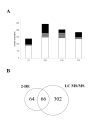A large-scale electrophoresis- and chromatography-based determination of gene expression profiles in bovine brain capillary endothelial cells after the re-induction of blood-brain barrier properties
- PMID: 21078152
- PMCID: PMC2993662
- DOI: 10.1186/1477-5956-8-57
A large-scale electrophoresis- and chromatography-based determination of gene expression profiles in bovine brain capillary endothelial cells after the re-induction of blood-brain barrier properties
Abstract
Background: Brain capillary endothelial cells (BCECs) form the physiological basis of the blood-brain barrier (BBB). The barrier function is (at least in part) due to well-known proteins such as transporters, tight junctions and metabolic barrier proteins (e.g. monoamine oxidase, gamma glutamyltranspeptidase and P-glycoprotein). Our previous 2-dimensional gel proteome analysis had identified a large number of proteins and revealed the major role of dynamic cytoskeletal remodelling in the differentiation of bovine BCECs. The aim of the present study was to elaborate a reference proteome of Triton X-100-soluble species from bovine BCECs cultured in the well-established in vitro BBB model developed in our laboratory.
Results: A total of 215 protein spots (corresponding to 130 distinct proteins) were identified by 2-dimensional gel electrophoresis, whereas over 350 proteins were identified by a shotgun approach. We classified around 430 distinct proteins expressed by bovine BCECs. Our large-scale gene expression analysis enabled the correction of mistakes referenced into protein databases (e.g. bovine vinculin) and constitutes valuable evidence for predictions based on genome annotation.
Conclusions: Elaboration of a reference proteome constitutes the first step in creating a gene expression database dedicated to capillary endothelial cells displaying BBB characteristics. It improves of our knowledge of the BBB and the key proteins in cell structures, cytoskeleton organization, metabolism, detoxification and drug resistance. Moreover, our results emphasize the need for both appropriate experimental design and correct interpretation of proteome datasets.
Figures





Similar articles
-
TNAP and EHD1 are over-expressed in bovine brain capillary endothelial cells after the re-induction of blood-brain barrier properties.PLoS One. 2012;7(10):e48428. doi: 10.1371/journal.pone.0048428. Epub 2012 Oct 31. PLoS One. 2012. PMID: 23119012 Free PMC article.
-
A differential proteomic approach identifies structural and functional components that contribute to the differentiation of brain capillary endothelial cells.J Proteomics. 2011 Dec 21;75(2):628-41. doi: 10.1016/j.jprot.2011.09.002. Epub 2011 Sep 23. J Proteomics. 2011. PMID: 21982828
-
Transfection of brain capillary endothelial cells in primary culture with defined blood-brain barrier properties.Fluids Barriers CNS. 2015 Aug 7;12:19. doi: 10.1186/s12987-015-0015-9. Fluids Barriers CNS. 2015. PMID: 26246240 Free PMC article.
-
Blood-brain barrier dysfunction in ischemic stroke: targeting tight junctions and transporters for vascular protection.Am J Physiol Cell Physiol. 2018 Sep 1;315(3):C343-C356. doi: 10.1152/ajpcell.00095.2018. Epub 2018 Jun 27. Am J Physiol Cell Physiol. 2018. PMID: 29949404 Free PMC article. Review.
-
Endothelial calcium dynamics, connexin channels and blood-brain barrier function.Prog Neurobiol. 2013 Sep;108:1-20. doi: 10.1016/j.pneurobio.2013.06.001. Epub 2013 Jul 10. Prog Neurobiol. 2013. PMID: 23851106 Review.
Cited by
-
TNAP and EHD1 are over-expressed in bovine brain capillary endothelial cells after the re-induction of blood-brain barrier properties.PLoS One. 2012;7(10):e48428. doi: 10.1371/journal.pone.0048428. Epub 2012 Oct 31. PLoS One. 2012. PMID: 23119012 Free PMC article.
-
Consensus brain-derived protein, extraction protocol for the study of human and murine brain proteome using both 2D-DIGE and mini 2DE immunoblotting.J Vis Exp. 2014 Apr 10;(86):51339. doi: 10.3791/51339. J Vis Exp. 2014. PMID: 24747743 Free PMC article.
-
Major remodeling of brain microvessels during neonatal period in the mouse: A proteomic and transcriptomic study.J Cereb Blood Flow Metab. 2017 Feb;37(2):495-513. doi: 10.1177/0271678X16630557. Epub 2016 Jul 21. J Cereb Blood Flow Metab. 2017. PMID: 26873886 Free PMC article.
-
Comparative and Quantitative Global Proteomics Approaches: An Overview.Proteomes. 2013 Oct 11;1(3):180-218. doi: 10.3390/proteomes1030180. Proteomes. 2013. PMID: 28250403 Free PMC article. Review.
-
Dissecting gene expression at the blood-brain barrier.Front Neurosci. 2014 Nov 6;8:355. doi: 10.3389/fnins.2014.00355. eCollection 2014. Front Neurosci. 2014. PMID: 25414634 Free PMC article. Review.
References
-
- Pries AR, Kuebler WM. Normal endothelium. Handb Exp Pharmacol. 2006. pp. 1–40. full_text. - PubMed
LinkOut - more resources
Full Text Sources

